Samurai Time Slip
Pagentry and Thrills at the Soma Nomaoi Festival
2018/09/30 Update date
The Soma Nomaoi festival takes place in Haranomachi, Tohoku, at the last weekend of July every year. It is a three day festival of various horse related events that has been designated an Important Intangible Folk Cultural Property of Japan. The event is said to have a history of over a thousand years, and derive from the military exercises of the warriors of Taira Masakado (903-940), from who the Soma clan claim descent (Masakado's childhood name was Soma Kojiro). The Soma clan were centered around Soma-Nakamura castle (also known as Mutsu-Nakamura castle), who had been in the area since from the Kamakura period (1185-1332) right up until the Boshin war (1868). The main part of the castle was taken down in the Meiji period, but the surrounding grounds and a gate remain. The Soma clan crest can still be seen everywhere around the Soma area, but most notably on the three main shrines (Nakamura, Ohta and Odaka) that are associated with the event and the mikoshi portable shrines that are escorted to the event field.
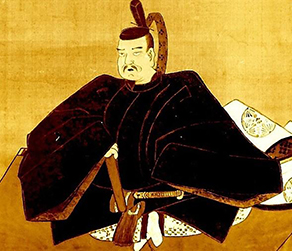 Taira Masakado (Soma Kojiro).
Taira Masakado (Soma Kojiro).
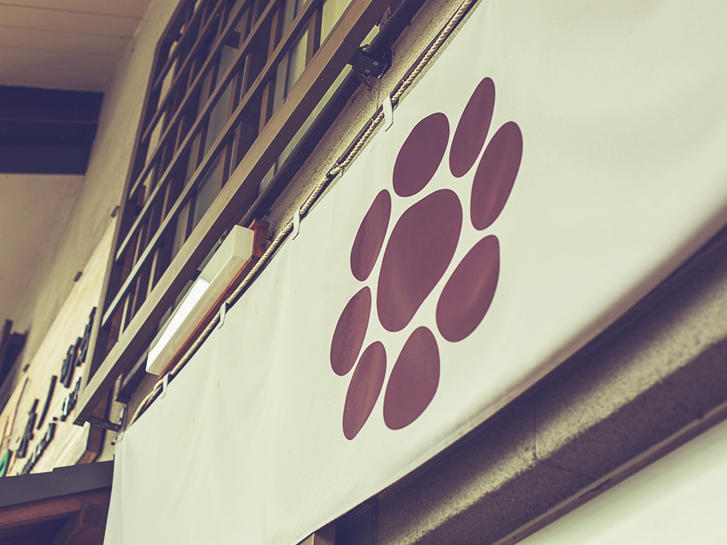 Soma Clan Crest.
Soma Clan Crest.
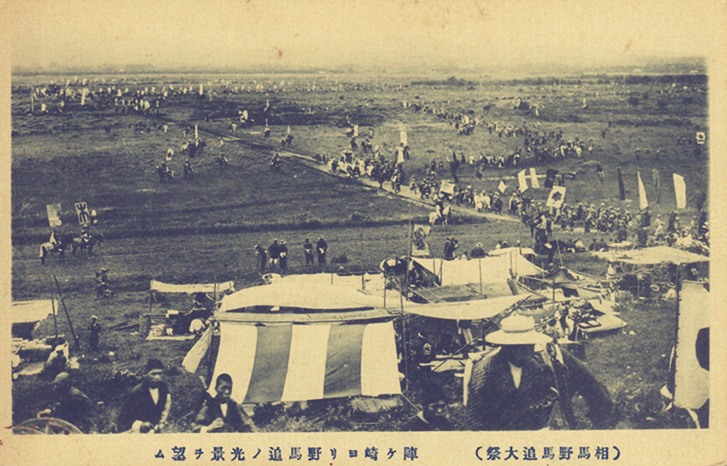 Antique Postcard of the Soma Nomaoi Festival.
Antique Postcard of the Soma Nomaoi Festival.
The festival is not only a fabulous display of samurai skills, it is actually a Shinto festival. The streets leading the way to the event field are lined with shinto sacred ropes, with the field itself encompassed by one. If you are a samurai enthusiast this is a must see event on the Japanese calender. However, there is something for everyone. If you like horses, period costumes, pagentry or the thrills of racing, this event is for you.
The Events
Saturday
The first day of events begins with various groups of riders and people in samurai costume paying their respects at the three main shrines. This involves formal ceremonies with people dressed as warriors making prayers to the shrines and pledges and their superiors. Following this, teams of riders proceed to Hibarigahara field, and representatives of the groups ride up to the judges stand and introduce themselves in a samurai like manner loud voice. The last event of the first day is the Yoinori horse races with warriors in samurai armor wearing jimbaori (surcoat), but not wearing flags. This is considered a pre-event for the main events the next day.
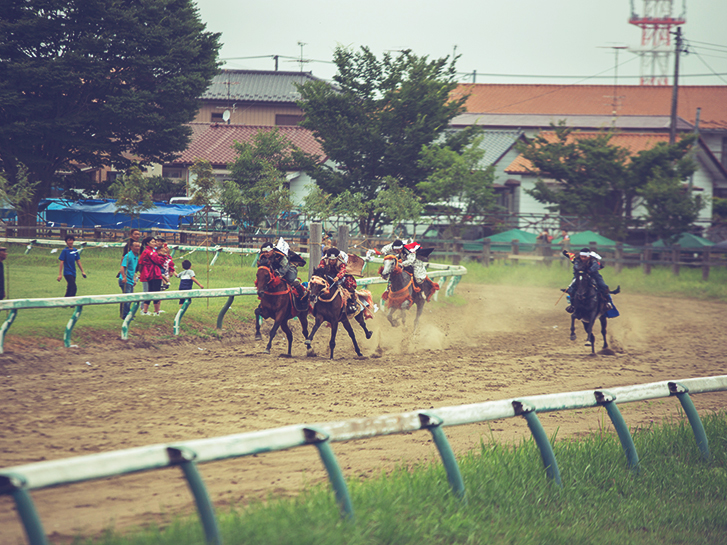
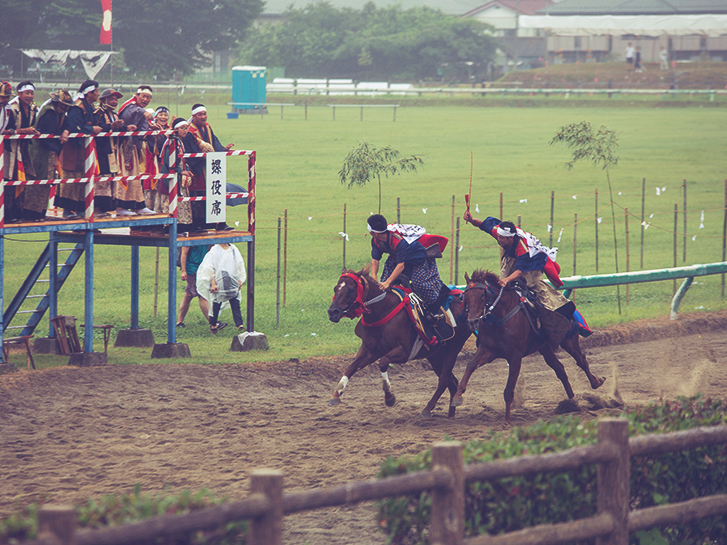
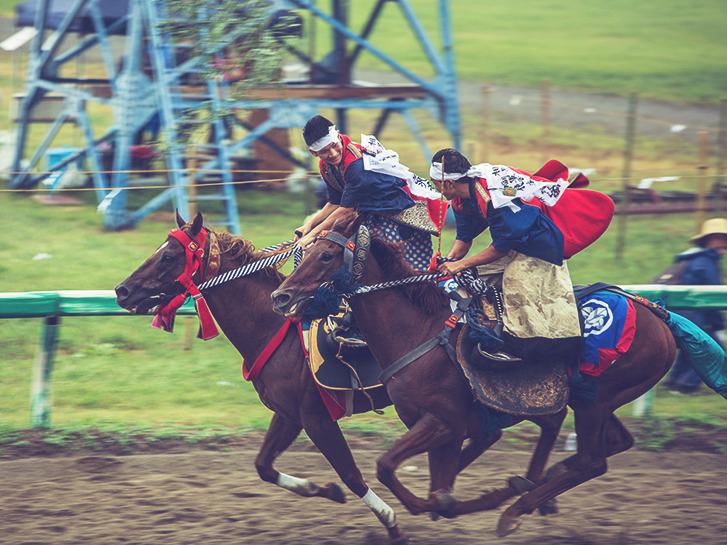 Introductions
Introductions
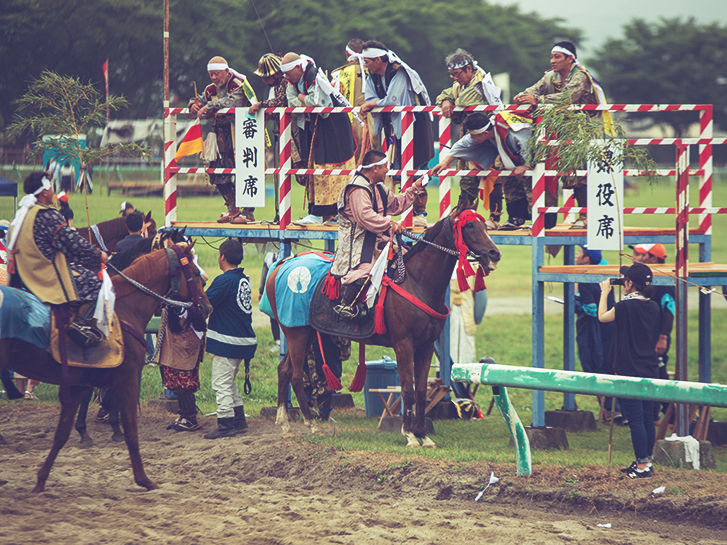 Yoinori Riders Wearing Jimbaori
Yoinori Riders Wearing Jimbaori
Sunday
Ceremonies begin with armor clad warriors attending each of the three shrines, and escorting the Mikoshi (portable shrines containing the patron deities) to the event field from Nakamura, Ohta and Odaka Shrines to oversee the days events and protect the partcipants from harm. The coordinated procession, called Ogyouretsu, lasts for around fifty minutes sometimes accompanied by songs and conch shell blowing. All of the riders, some four hundred and fifty mounted samurai, proceed down the main street, punctuated by groups of foot samurai carrying yari (spears) or what appear to be covered arquebuses, and groups of people clad in ceremonial Shinto clothing, escorted by a Shinto preist (also on horseback). For what feels like a rather long time, there are mounted samurai as far as the eye can see in both directions.
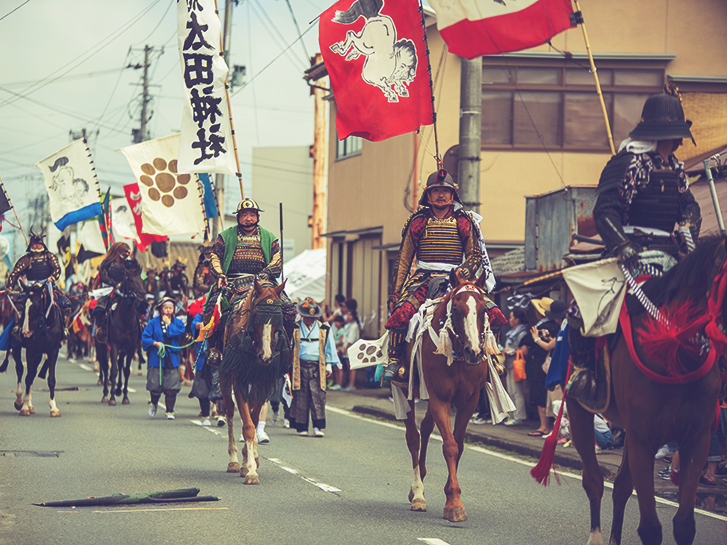
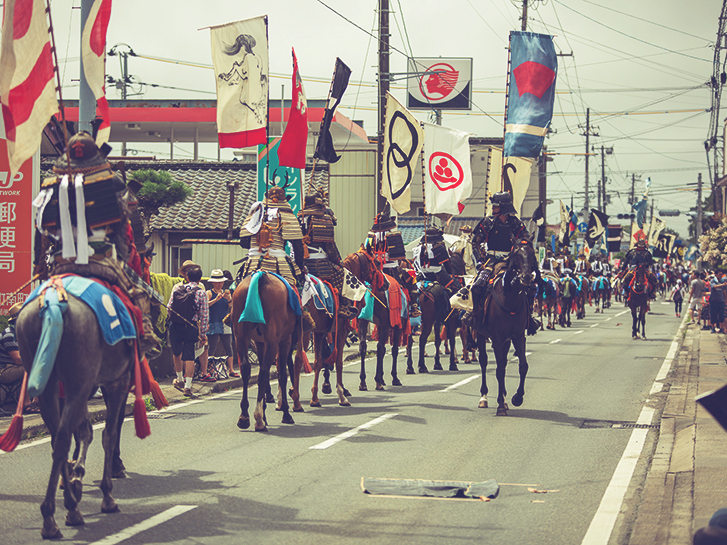 Ogyouretsu: mounted samurai as far as the eye can see in both directions
Ogyouretsu: mounted samurai as far as the eye can see in both directions
As well as mounted samurai males, there are also a handfull of women that take part in the events including racing and the Shinki Sodatsusen. In addition to this there are some children in traditional costume riding horses in the Ogyouretsu. This is obviously the early stages of training for future generations of participants. There is tension in the air too, as occaisonally a group leader will come back and reprimand the riders in his group for being too slow. Although this is for show, it conveys the austerity of the event, and how seriously it carried out to recreate the discipline of feeling of samurai life. In the past, tardyness or misconduct in front of one's daimyo could have been costly.
Although Daimyo no longer exist in Japan, Soma Yukitane is still regarded as the 34th generation head of the clan. As per Soma Ogyouretsu tradition, the clan head wears a bright red silk horo attached to his back. A horo is a Japanese medieval device for the defense of mounted horsemen from arrows fired at them from behind. It is said that Horo are traditionally constructed using a lightweight cage out of whale beard. However, it is very common for them to be made from the rather more robust and lightweight strips of bamboo, then covered in a sheet of silk. Other people of position in the clan wear horo of different colors.
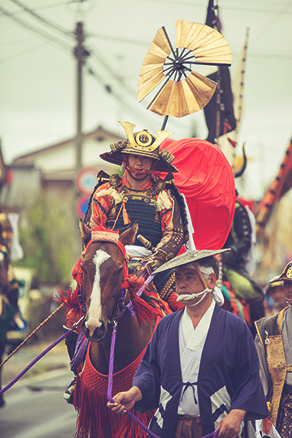 34th generation Clan Head Soma Yukitane wearing a red horo
34th generation Clan Head Soma Yukitane wearing a red horo
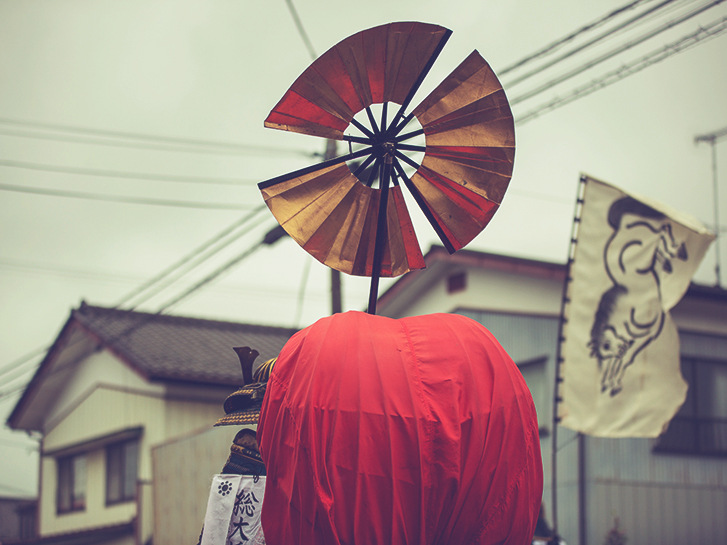 Horo from behind
Horo from behind
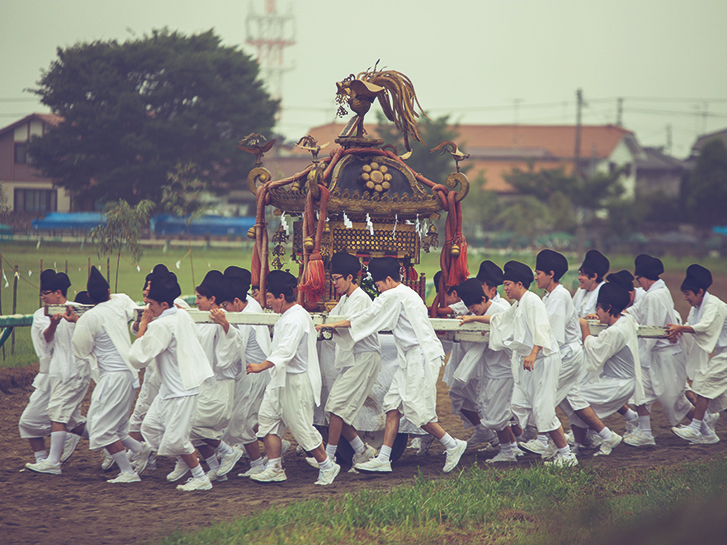 Shinto Mikoshi with Soma crest being carried to the field
Shinto Mikoshi with Soma crest being carried to the field
The procession, and attention to detail is stunning. Many people wear modern replica armors, and replica swords, but there are still quite a few wearing antique armor. In addition to this, every single mounted warrior that I saw was using antique abumi (samurai stirrups). These are special stirrups that were devised so that samurai warriors could stand up easily while on horseback in order to use a bow and arrow more effectively. This type of stirrups began to be used around the 11th-12th century, and have probably not been made for at least a hundred and fifty years. Many of these abumi are heavily decorated with carvings, inlaid soft metals, and maki-e designs using Japanese urushi lacquer. All of the riders also use traditional Japanese wooden saddles called, kura. These too are often richly decorated with urushi designs, or clan badges.
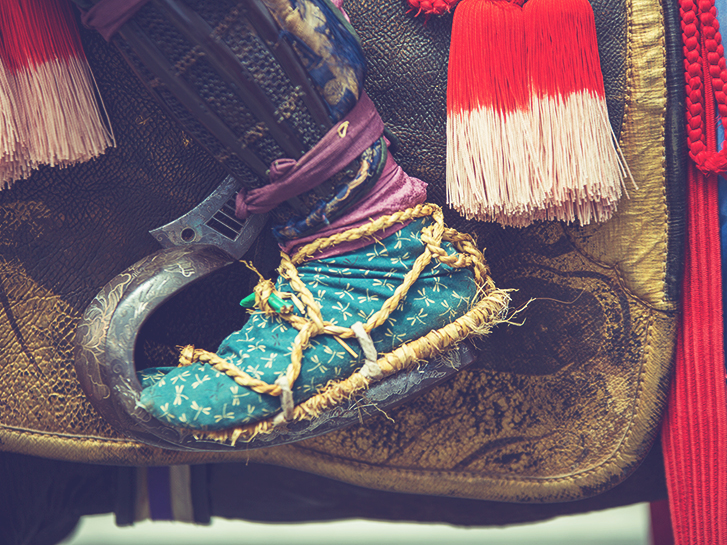 Abumi (Samurai stirrups)
Abumi (Samurai stirrups)
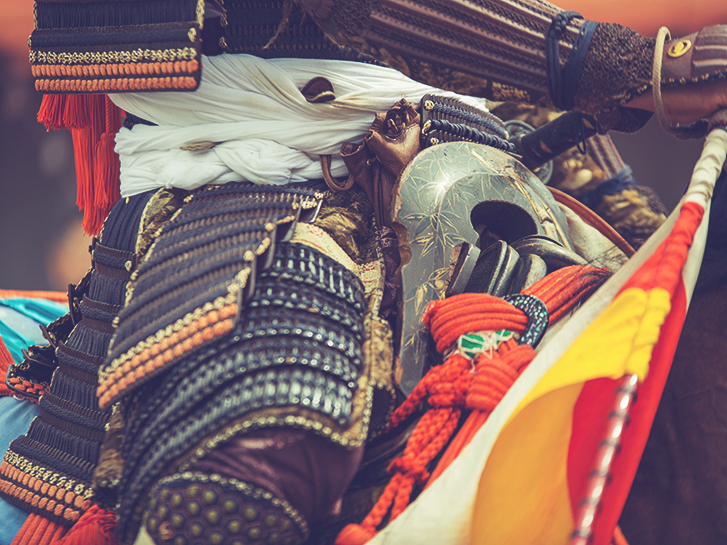 Kura
Kura
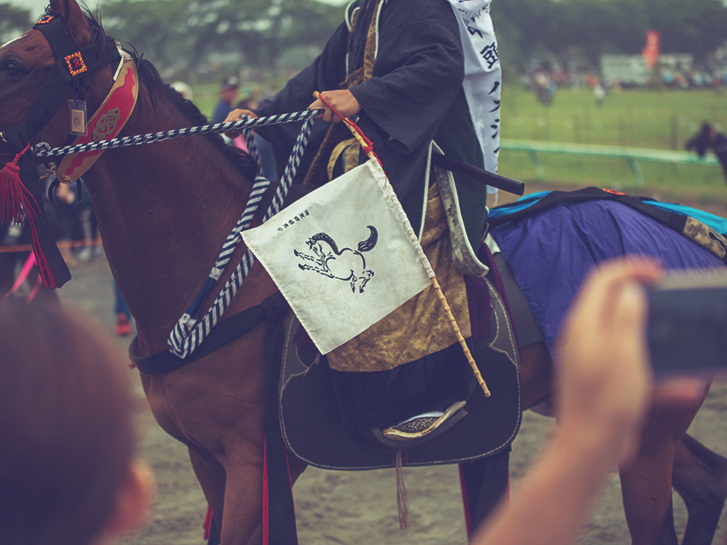 Muchi
Muchi
Although not antique, all of the riders carry a wooden or bamboo versatile baton called a muchi. A muchi is used as a riding crop, but they also have a flag attached to them with a clan crest or other design that can be used for signaling, and are a vital tool when it comes to the Shinki Sodatsusen event. Last but not least, is the rich array of traditional silk costumes. The majority of them are mostly hidden under the armor of the riders, but there are many worn by the other participants who are not riders and are still taking part in the event in some way.
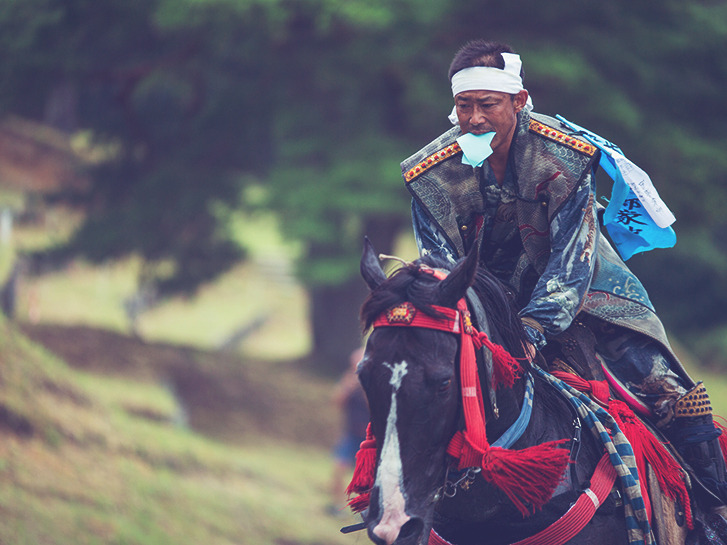
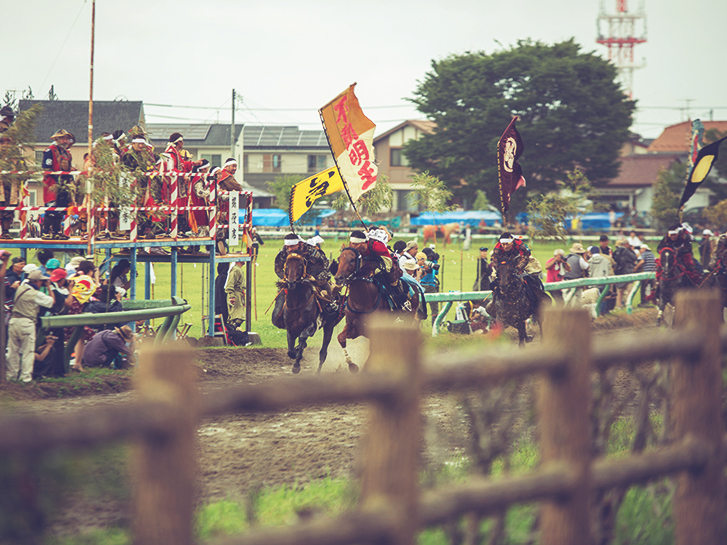
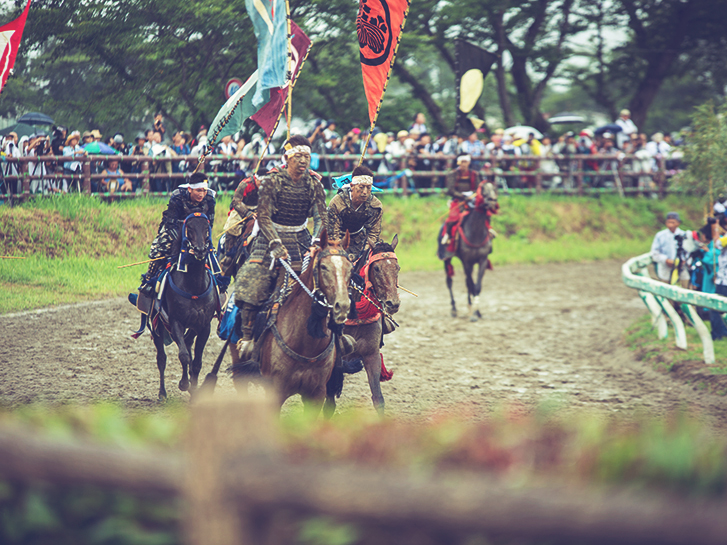 Katchu Keiba
Katchu Keiba
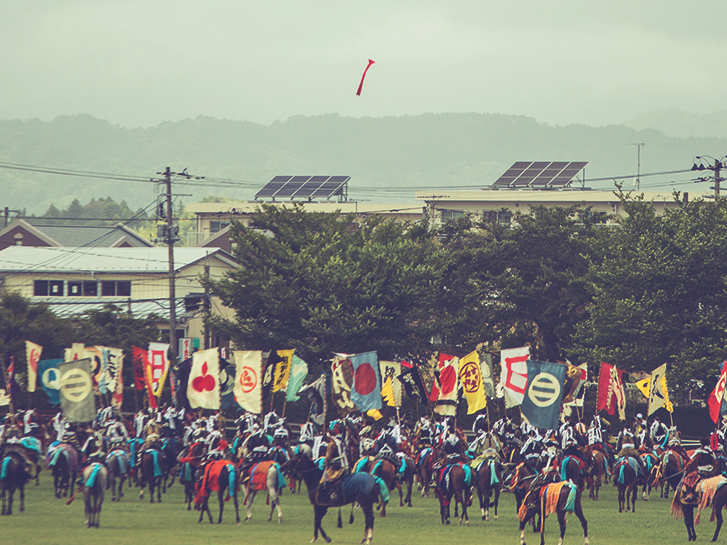
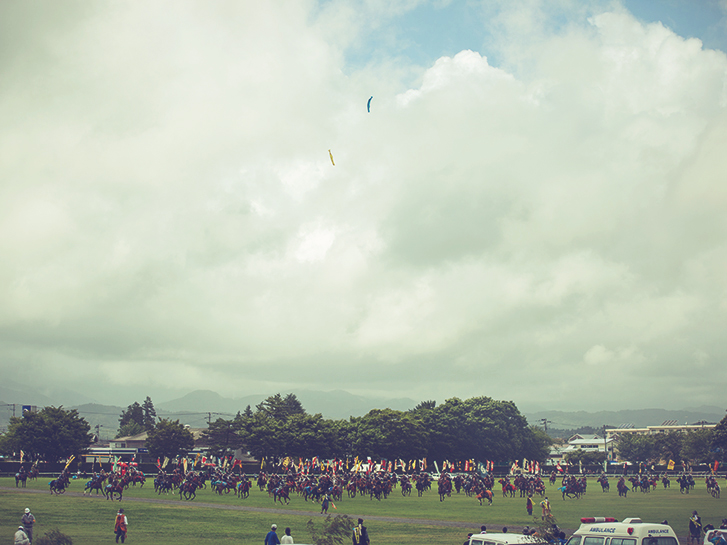 Shinki Sodatsusen
Shinki Sodatsusen
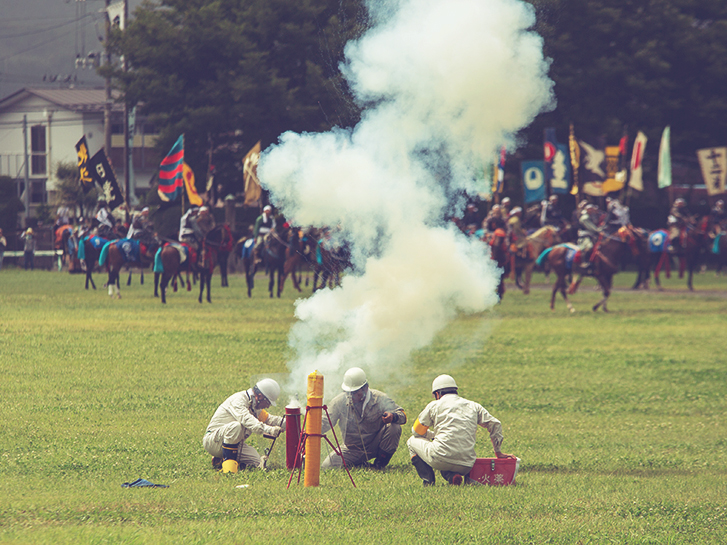 Flamboyant costume
Flamboyant costume
The first series of events is the Katchu Keiba, men wearing samurai armor (katchu) with large flags (nobori-bata) on their backs while racing horses around the track. There are up to ten races take place. Riders are prone to falling off, and sometimes the wet weather adds to the excitement. However, it is not for the feint hearted as it is rather dangerous and serious injuries can occur, but there is an ambulance on site just in case throughout the events.
This is followed by the wild looking event of the Shinki Sodatsusen, where three or four sacred banners at a time from the three local shrines (Red: Nakamura, Blue: Ohta, and Yellow: Odaka) shot into the air from a mortar like device. As the banners slowly drift down, scores of mounted samurai scramble and use their muchi to try to be first to grab one. With the explosive sounds of the mortars, and riders sometimes falling off their horses, the excitement is palpable. The loose horses then run wild towards the groups of people who are allowed in the main enclosure, but are eventually (quite physically) apprehended by staff, to stop any injuries involving spectators, other riders, or to the horses themselves.
Monday
The final event is called Nomagake, also known as the wild horse chase. Wild rider-less horses are released, and herded along a route by mounted riders until they enter a special enclosure at Odaka shrine, where they then have to be caught by several men on foot dressed in ceremonial white Shinto clothing. The horses are then bridled using sacred Shinto reed ropes, and presented to, Myoken Bosatsu, the patron deity of the shrine and a protector of horses. It is said that this dedication ceremony is the real roots of the event.
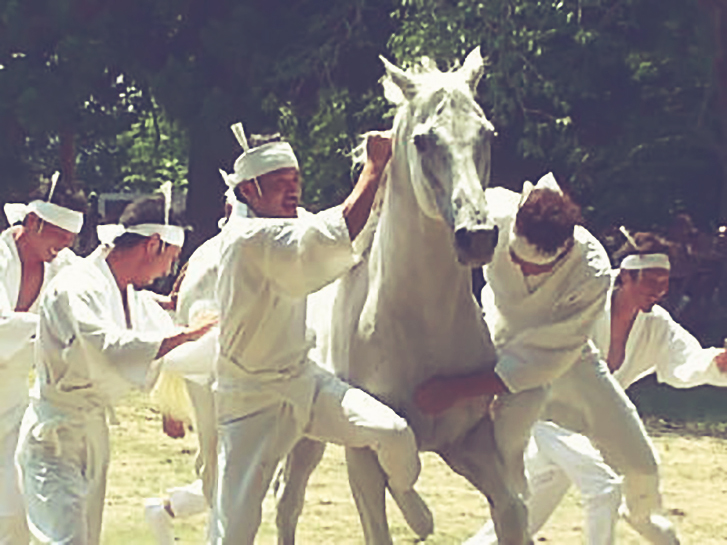 Nomagake (Minami Soma City Museum)
Nomagake (Minami Soma City Museum)
Taira Masakado is considered by many as the first samurai. It would be too easy to say the the current modern warriors of Soma are the 'Last Samurai'. However, I do not think that they will be, I think that Soma will be preserving the samurai spirit and producing samurai warriors for many generations to come.
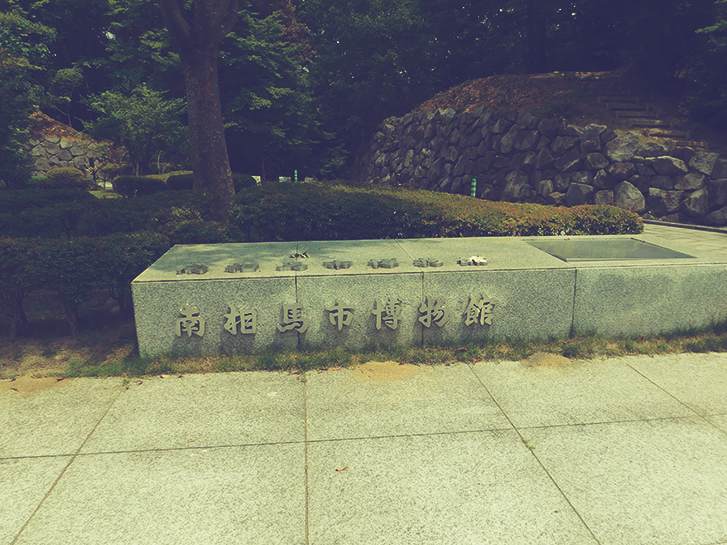
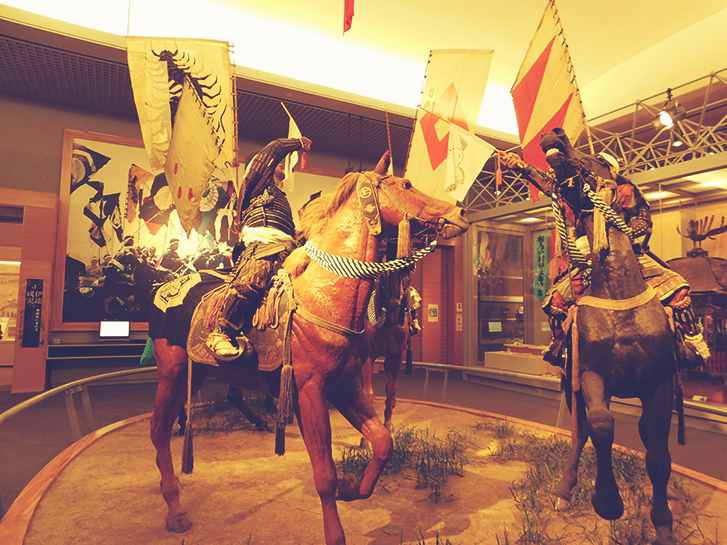 Minami Soma City Museum
Minami Soma City Museum
Points of note:
Soma City MuseumThe Soma City Museum is within walking distance of the main event space, Hibarigahara field. There are several displays about the history of the area and one gallery dedicated to special exhibitions, but the center piece is the gallery on Soma Nomaoi and its history. There are three life size models of mounted Soma warriors in armor clambering to try to catch a descending shinki (religious banner). The Museum is in walking distance from event field, and can be a welcome break from the sun (or the rain).
Haranomachi Station
Around the time of the festival, the station staff wear jimbaori, and there is a small Soma Nomaoi exhibition inside the station. Also, they have samurai armor that you can try on and take photos, all free of charge! It is a great opportunity to feel like a samurai of Soma. You also have the choice to wear a helmet, or a white bandana like the racers.
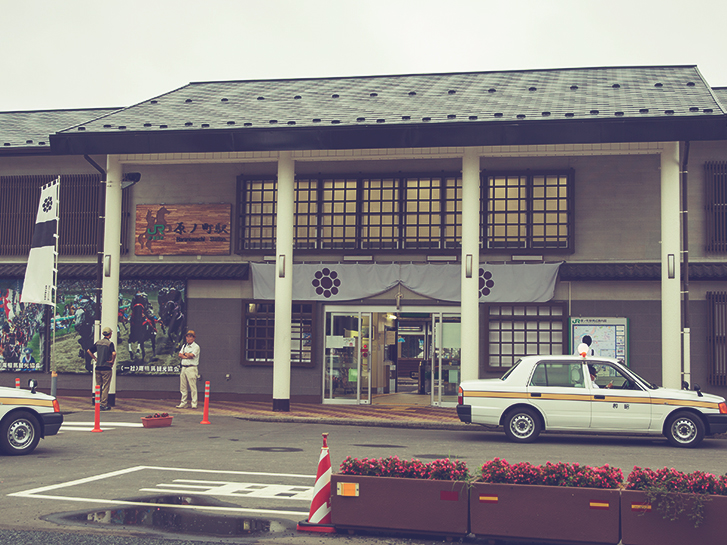 Haranomachi Station
Haranomachi Station
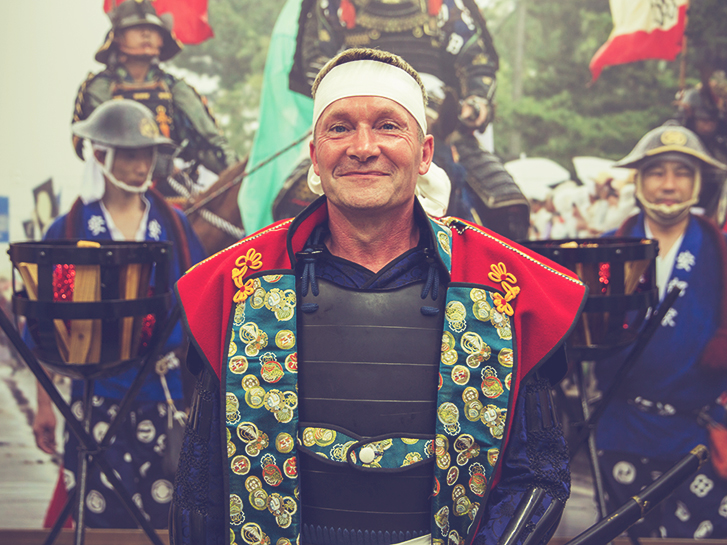 Trying Armor at Haranomachi Station
Trying Armor at Haranomachi Station
Etiquette
Although today, not all of the partcipants are descended from the Soma samurai lineages, the event strictly adheres to traditional values of the samurai. Please take care not to cross the road during the Ogyouretsu procession, or call out to the mounted warriors. Additionally, avoid using your flash on your camera, or any other things that may startle the horses.
Be Prepared
Tickets are required for the Sunday events at Hibarigahara field (children free). They go on sale from around June every year, and are purchasable from convenience stores all over Japan and cost 800 JPY advanced booking, or 1000 JPY on the day. Further details can be found on the Soma Nomaoi official website: http://soma-nomaoi.jp/en/top-page/
http://soma-nomaoi.jp/en/top-page/
The event field and viewing area is a wide open space with very little shade or cover. The event is held in early summer and the weather can be rather hot and humid. It is a long day in the open. Hats, plenty of fluids and copius amounts of sunscreen are highly recommended. Occasionally, there can be rain, with no cover and seating is tiered grass and gravel areas. So, it is best to take a picnic sheet or something to sit on (but no chairs). By all means pack a picnic, but there is also reasonably priced food and drinks on sale on site, as well as some souvineers.







